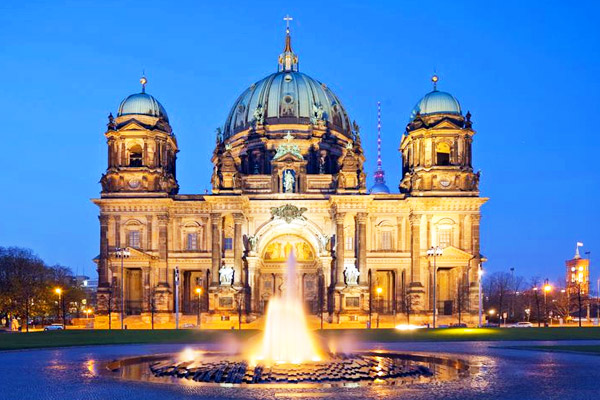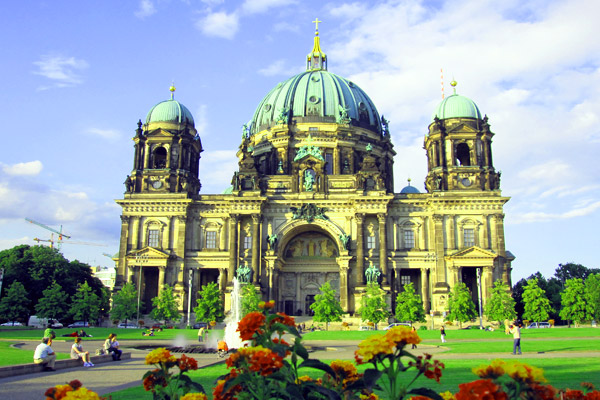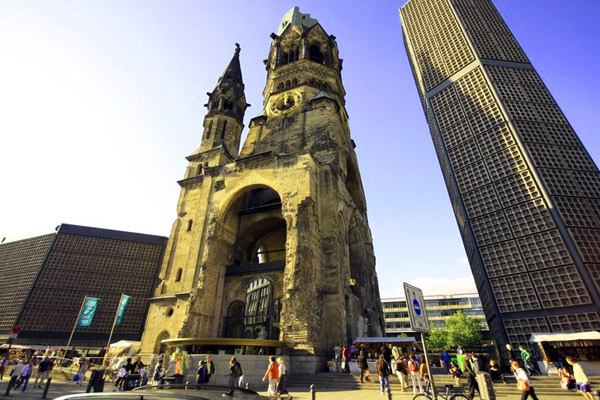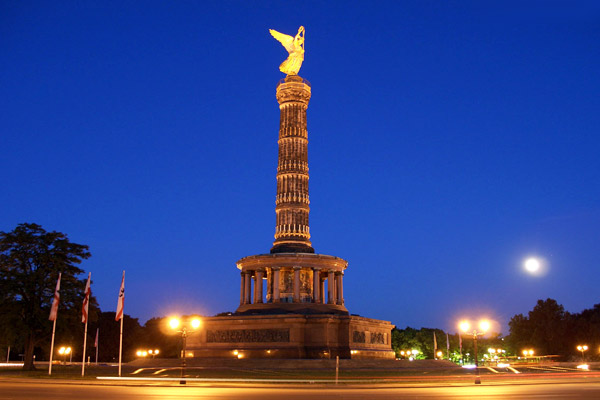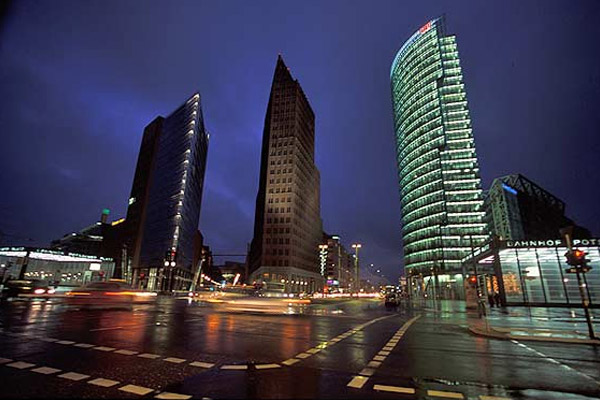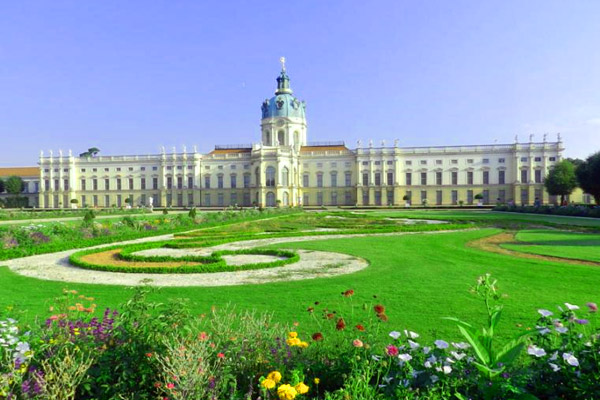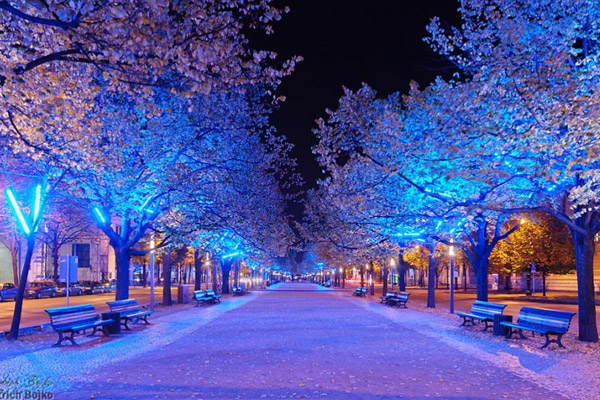Berlin
The Walled City
General Information
Other Name: The Capital City, , State: Berlin, Germany
Area: 892 km²
Languages Spoken: German and English
Long Distance Code: +49 30
Importance: Berlin is a major center in European politics, culture, media, and science.
Best Time to Visit: May to September and April
International Access: Connected to all the kajor cities of the world.
Description
Berlin is the capital city of Germany and one of the 16 states (Länder) of the Federal Republic of Germany. Berlin is the largest city in Germany and has a population of 4.3 million within its metropolitan area and 3.4 million within the city limits.Location
Berlin is located in eastern Germany, about 70 kilometers (44 mi) west of the border with Poland in an area with marshy terrain.Climate
Cool and Humid Climate
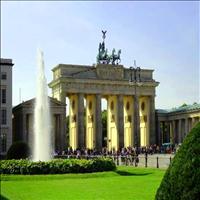 Commissioned by Friedrich Wilhelm II in the 1700s to represent peace, the Brandenburg Gate has become one of Berlin's most recognisable and photographed landmarks. Originally built as a customs post, the gate was an integral part of the Berlin Wall and remained locked for the duration of the Communist rule. When the wall that was once the boundary between East and West Berlin was knocked down, the gate became an important symbol of German reunification and it is the only one out of 18 such gates that now remains. Designed in 1791 by Carl Gotthard Langhans, a detailed sculpture of the beautiful goddess Victory resides at the top of the structure.
Commissioned by Friedrich Wilhelm II in the 1700s to represent peace, the Brandenburg Gate has become one of Berlin's most recognisable and photographed landmarks. Originally built as a customs post, the gate was an integral part of the Berlin Wall and remained locked for the duration of the Communist rule. When the wall that was once the boundary between East and West Berlin was knocked down, the gate became an important symbol of German reunification and it is the only one out of 18 such gates that now remains. Designed in 1791 by Carl Gotthard Langhans, a detailed sculpture of the beautiful goddess Victory resides at the top of the structure.Across William Street (Wilhelmstraße) a road across the old and the new government district (Regierungsviertel) and embassy district (Botschaftsviertel), leading to the Brandenburg Gate (Brandenburger Tor) and the Houses of Parliament (Reichstag) direction. The district government building unique combination of old and new, iconic yet elegant style, the Federal Chancellery (Bundeskanzleramt) is particularly striking. Here you can Outlook Capitol (Reichstag), one of Berlin's most important attractions. British star architect Norman Foster (Norman Foster) round its glass dome designed charm, firmly attracted the attention of international tourists.
 In the 1900s this was one of the busiest squares in the whole of Europe and when the Berlin Wall was built it had a platform that allowed Westerners to look over the wall and into the eastern part of the city. After many years of neglect, recent restoration and renovation have created a wonderful new, vibrant area, full of shops, bars, cafés, restaurants and many other venues for entertainment. Once again it is a thriving square and is rapidly becoming the heart of the city. There are many modern constructions and the Sony Centre has a large, contemporary roof that resembles a sail. For some of the best views in the city, visit Panorama-Point, which is situated at the very top of the tall Kollhof building. A lift is available and it is thought to be the fastest lift in Europe. The Potsdamer Platz is easy to reach by either U-Bahn, S-Bahn or bus.
In the 1900s this was one of the busiest squares in the whole of Europe and when the Berlin Wall was built it had a platform that allowed Westerners to look over the wall and into the eastern part of the city. After many years of neglect, recent restoration and renovation have created a wonderful new, vibrant area, full of shops, bars, cafés, restaurants and many other venues for entertainment. Once again it is a thriving square and is rapidly becoming the heart of the city. There are many modern constructions and the Sony Centre has a large, contemporary roof that resembles a sail. For some of the best views in the city, visit Panorama-Point, which is situated at the very top of the tall Kollhof building. A lift is available and it is thought to be the fastest lift in Europe. The Potsdamer Platz is easy to reach by either U-Bahn, S-Bahn or bus.
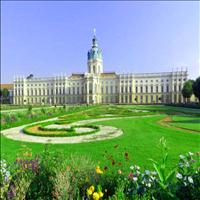 This beautifully restored palace was originally commissioned over 300 years ago by the future Queen Sophie Charlotte. In the early 19th century extra details and interesting features were added by Karl Friedrich Schinkel. Inside the palace there is a small collection of romantic paintings. Outside, the Schloss Charlottenburg is surrounded by stunning gardens, which are well worth a visit, opening from dawn until dusk.
This beautifully restored palace was originally commissioned over 300 years ago by the future Queen Sophie Charlotte. In the early 19th century extra details and interesting features were added by Karl Friedrich Schinkel. Inside the palace there is a small collection of romantic paintings. Outside, the Schloss Charlottenburg is surrounded by stunning gardens, which are well worth a visit, opening from dawn until dusk.
Attraction open: Tuesday to Friday 09:00 to 17:00, Saturday and Sunday 10:00 to 17:00
Last tour: 16:00 (Old Palace), Tuesday to Friday 10:00 to 18:00, Saturday and Sunday 11:00 to 18:00 (New Wing)
Grounds: open daily, summer 06:00 to 21:00, winter 06:00 to 20:00
Attraction admission: charge
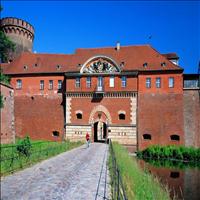 Built in the 16th century, this ancient fortress is surrounded by a moat and is now the oldest building in Berlin that is not religious. Guided tours of the Spandau Citadel are available at the weekend, but only by advanced request, and this is an interesting way to learn about the history of the structure. There are many Jewish gravestones that are built directly into the fortress wall. It is situated near to the River Havel and overlooks the small town of Spandau. This is a charming area of the city and is well worth a visit.
Built in the 16th century, this ancient fortress is surrounded by a moat and is now the oldest building in Berlin that is not religious. Guided tours of the Spandau Citadel are available at the weekend, but only by advanced request, and this is an interesting way to learn about the history of the structure. There are many Jewish gravestones that are built directly into the fortress wall. It is situated near to the River Havel and overlooks the small town of Spandau. This is a charming area of the city and is well worth a visit.
Attraction open: Tuesday to Friday 09:00 to 17:00, Saturday and Sunday 10:00 to 17:00
Attraction admission: charge
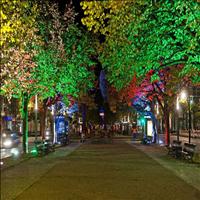 The Unter den Linden is a long avenue that stretches 1 mile / 1.5 km from the Brandenburg Gate (Brandenburger Tor), one of Berlin's most recognisable landmarks, to the Schlossbrücke. Before it was developed as a showpiece road, Unter den Linden was just a simple riding path that connected the Tiergarten to the Berliner Stadtschloss. The enormous linden trees were planted in the 17th century, but the striking blend of neoclassical and baroque structures continued to be built for another 100 years. With heavy damage in the war, much of the architecture in this splendid avenue now reflects postwar tastes and the eastern part has been beautifully restored. Some of Berlin's most treasured and important buildings lie on this road and these include the German State Opera (Deutsche Staatsoper) and the German Historical Museum (Deutsches Historisches), which is housed in the Arsenal (Zeughaus).
The Unter den Linden is a long avenue that stretches 1 mile / 1.5 km from the Brandenburg Gate (Brandenburger Tor), one of Berlin's most recognisable landmarks, to the Schlossbrücke. Before it was developed as a showpiece road, Unter den Linden was just a simple riding path that connected the Tiergarten to the Berliner Stadtschloss. The enormous linden trees were planted in the 17th century, but the striking blend of neoclassical and baroque structures continued to be built for another 100 years. With heavy damage in the war, much of the architecture in this splendid avenue now reflects postwar tastes and the eastern part has been beautifully restored. Some of Berlin's most treasured and important buildings lie on this road and these include the German State Opera (Deutsche Staatsoper) and the German Historical Museum (Deutsches Historisches), which is housed in the Arsenal (Zeughaus).
Berlin Getaway / PC-101 (4 Days / 3 Nights)
Berlin
Berlin Getaway
Detailed Itinerary
Day 1 : Berlin
Day 2 : Berlin
Day 3 : Berlin
Day 4 : Berlin
Berlin
Berlin Getaway
Detailed Itinerary
Day 1 : Berlin
Day 2 : Berlin
Day 3 : Berlin
Day 4 : Berlin
Highlights of Germany / PC-102 (14 Days / 13 Nights)
Frankfurt-Eisenach-Weimar-Dresden-Wittenberg-Potsdam-Berlin-Hamburg-Bremen-Hamelin-Frankfurt-Wurzburg-Rothenburg-Augsburg-Munich-Garmisch-Partenkirchen-Ettal-Oberammergau-Fuessen-Hohenschwangau-Linderhof-Rottenbuch-Fuessen-Lindau-Lake Constance-Black Forest-Freiburg-Heidelberg-Ruedesheim-Frankfurt
Highlights of Germany
Detailed Itinerary
Day 1 : Frankfurt-Eisenach-Weimar
Day 2 : Weimar-Dresden
Day 3 : Dresden-Wittenberg-Potsdam-Berlin
Day 4 : Berlin
Day 5 : Berlin-Hamburg
Day 6 : Hamburg-Bremen-Hamelin
Day 7 : Hamelin-Frankfurt
Day 8 : Frankfurt-Wurzburg-Rothenburg
Day 9 : Rothenburg-Augsburg-Munich
Day 10 : Munich-Garmisch-Partenkirchen-Ettal-Oberammergau-Fuessen
Day 11 : Fuessen-Hohenschwangau-Linderhof-Rottenbuch-Fuessen
Day 12 : Fuessen-Lindau-Lake Constance
Day 13 : Lake Constance-Black Forest-Freiburg-Heidelberg
Day 14 : Heidelberg-Ruedesheim-Frankfurt
Frankfurt-Eisenach-Weimar-Dresden-Wittenberg-Potsdam-Berlin-Hamburg-Bremen-Hamelin-Frankfurt-Wurzburg-Rothenburg-Augsburg-Munich-Garmisch-Partenkirchen-Ettal-Oberammergau-Fuessen-Hohenschwangau-Linderhof-Rottenbuch-Fuessen-Lindau-Lake Constance-Black Forest-Freiburg-Heidelberg-Ruedesheim-Frankfurt
Highlights of Germany
Detailed Itinerary
Day 1 : Frankfurt-Eisenach-Weimar
Day 2 : Weimar-Dresden
Day 3 : Dresden-Wittenberg-Potsdam-Berlin
Day 4 : Berlin
Day 5 : Berlin-Hamburg
Day 6 : Hamburg-Bremen-Hamelin
Day 7 : Hamelin-Frankfurt
Day 8 : Frankfurt-Wurzburg-Rothenburg
Day 9 : Rothenburg-Augsburg-Munich
Day 10 : Munich-Garmisch-Partenkirchen-Ettal-Oberammergau-Fuessen
Day 11 : Fuessen-Hohenschwangau-Linderhof-Rottenbuch-Fuessen
Day 12 : Fuessen-Lindau-Lake Constance
Day 13 : Lake Constance-Black Forest-Freiburg-Heidelberg
Day 14 : Heidelberg-Ruedesheim-Frankfurt
Germany Train Tour / PC-103 (9 Days / 8 Nights)
Frankfurt-Colonge-Hamburg-Berlin-Dresden-Munich-Frankfurt
Germany Train Tour
Detailed Itinerary
Day 1 : Frankfurt
Day 2 : Frankfurt-Colonge
Day 3 : Colonge-Hamburg
Day 4 : Hamburg-Berlin
Day 5 : Berlin
Day 6 : Berlin-Dresden
Day 7 : Dresden-Munich
Day 8 : Munich
Day 9 : Munich-Frankfurt
Frankfurt-Colonge-Hamburg-Berlin-Dresden-Munich-Frankfurt
Germany Train Tour
Detailed Itinerary
Day 1 : Frankfurt
Day 2 : Frankfurt-Colonge
Day 3 : Colonge-Hamburg
Day 4 : Hamburg-Berlin
Day 5 : Berlin
Day 6 : Berlin-Dresden
Day 7 : Dresden-Munich
Day 8 : Munich
Day 9 : Munich-Frankfurt
The Roots of the Reformation / PC-104 (9 Days / 8 Nights)
Munich-Augsburg-Nuremberg-Rothenburg-Heidelberg-Speyer-Worms-Wurzburg-Coburg-Erfurt-Eisleben-Leipzig-Torgau-Wittenberg-Berlin-Spandau-Berlin
The story of Martin Luther’s life and the history of the Reformation in Germany are attracting growing interest around the world. Visit the historic cities of Germany, the epicenter of the 16th century Protestant Reformation. Follow Luther’s footsteps across this beautiful country and historic cities.
Detailed Itinerary
Day 1 : Munich-Augsburg
Day 2 : Augsburg-Nuremberg
Day 3 : Nuremberg-Rothenburg-Heidelberg
Day 4 : Heidelberg-Speyer-Worms-Wurzburg
Day 5 : Wurzburg-Coburg-Erfurt
Day 6 : Erfurt-Eisleben-Leipzig
Day 7 : Leipzig-Torgau-Wittenberg
Day 8 : Wittenberg-Berlin-Spandau-Berlin
Munich-Augsburg-Nuremberg-Rothenburg-Heidelberg-Speyer-Worms-Wurzburg-Coburg-Erfurt-Eisleben-Leipzig-Torgau-Wittenberg-Berlin-Spandau-Berlin
The story of Martin Luther’s life and the history of the Reformation in Germany are attracting growing interest around the world. Visit the historic cities of Germany, the epicenter of the 16th century Protestant Reformation. Follow Luther’s footsteps across this beautiful country and historic cities.
Detailed Itinerary
Day 1 : Munich-Augsburg
Day 2 : Augsburg-Nuremberg
Day 3 : Nuremberg-Rothenburg-Heidelberg
Day 4 : Heidelberg-Speyer-Worms-Wurzburg
Day 5 : Wurzburg-Coburg-Erfurt
Day 6 : Erfurt-Eisleben-Leipzig
Day 7 : Leipzig-Torgau-Wittenberg
Day 8 : Wittenberg-Berlin-Spandau-Berlin
Berlin, Dresden and Hamburg Tour Package / PC-105 (8 Days / 7 Nights)
Hamburg-Berlin-Dresden-Berlin
Berlin, Dresden and Hamburg Tour Package
Detailed Itinerary
Day 1 : Hamburg
Day 2 : Hamburg
Day 3 : Hamburg-Berlin
Day 4 : Berlin
Day 5 : Berlin
Day 6 : Berlin-Dresden
Day 7 : Dresden
Day 8 : Dresden-Berlin
Hamburg-Berlin-Dresden-Berlin
Berlin, Dresden and Hamburg Tour Package
Detailed Itinerary
Day 1 : Hamburg
Day 2 : Hamburg
Day 3 : Hamburg-Berlin
Day 4 : Berlin
Day 5 : Berlin
Day 6 : Berlin-Dresden
Day 7 : Dresden
Day 8 : Dresden-Berlin
Berlin, Germany Tours

